25 Best Turkey Cooking Hacks for the Perfect Bird Every Time
40 Best DIY Gift Ideas for Any Occasion
50 Gorgeous Handcrafted Wreaths on Etsy
10 Festive Christmas Simmer Pot Recipes
40 Dollar Store DIY Fall DÉcor Ideas
40 Easy Rotisserie Chicken Shortcut Meals
60 Christmas Cookies for Every Taste
Gift Guides for Everyone on Your List
55 Best Harry Potter Party Hacks
Make the most of fall and the holiday season with our best décor ideas, recipes, gift ideas & more.
SEe What's Trending
Learn More ›
Clean everything in your home from your clothes and sheets to your shower curtain, vents - even the inside of your washing machine - with simple short-cuts using all-natural cleaning products.
Available in paperback and
Kindle. editions.
Get the cleaning hacks book
Natural Cleaning
Home DÉcor
Christmas
Thanksgiving
Halloween
Fall
Recipes
Top Categories
More About Me ›
Hi, I'm Sarah! I share all the best recipes, lifestyle tips, décor ideas & more to help you live your best life, naturally. Come for meal ideas and life hacks, and stay for updates and community.
sarah blooms!
welcome to
Gift Guides
Ready to enjoy the best tasting turkey you’ve ever had this Thanksgiving? These Must-Know Turkey Cooking Hacks will make hosting Thanksgiving a cinch!
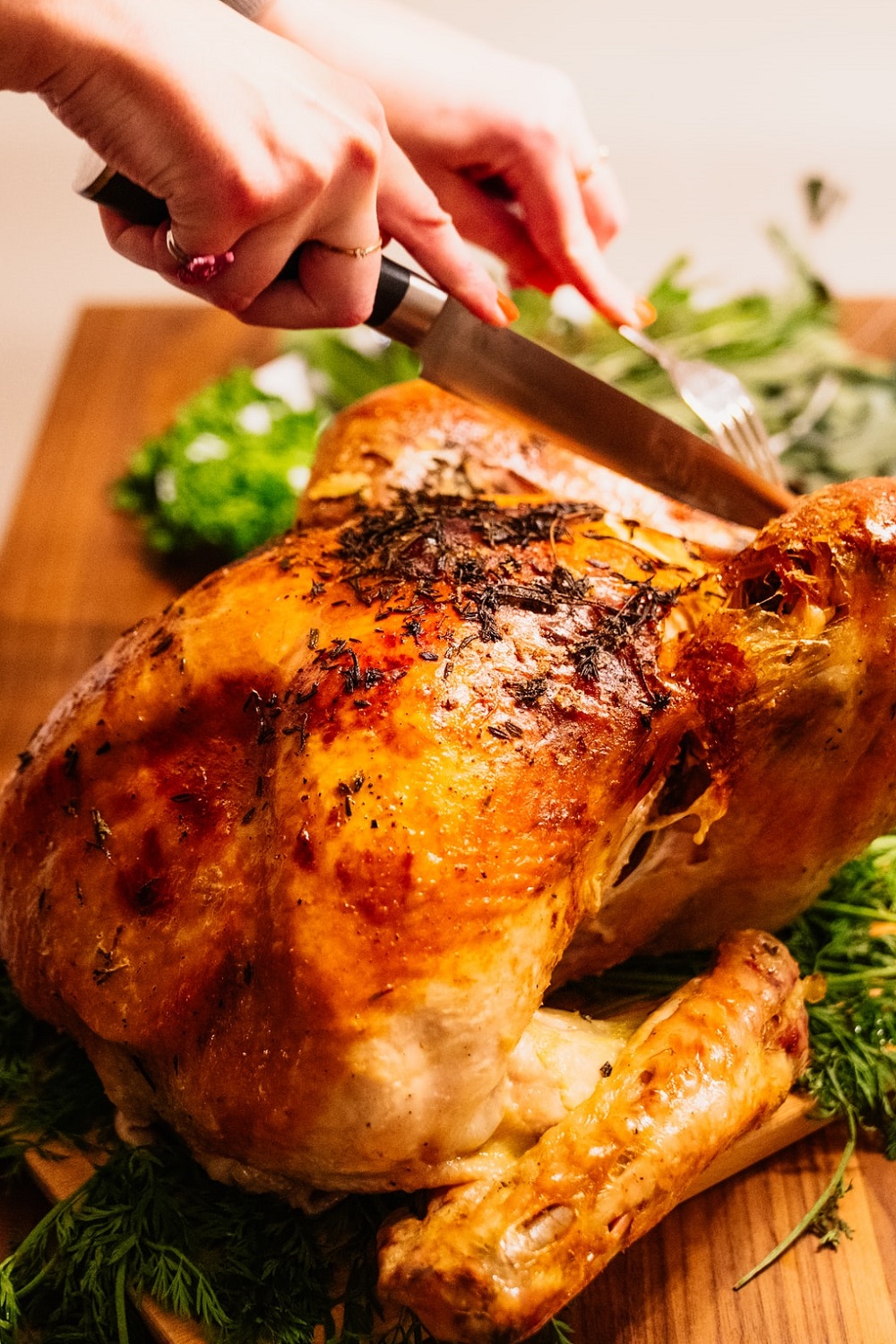
The turkey is the most important part of a traditional Thanksgiving meal.
It is at the center of the meal and the family table. Cooking the Thanksgiving turkey can be a seriously stressful task.
One small error can mean disaster, and you and your family will have to deal with a dry, overcooked bird for the holiday.
If you are nervous about hosting this Thanksgiving, you’ve come to the right place!
These Ingenious Turkey Cooking Hacks will help you put a perfectly cooked Thanksgiving turkey on the table this holiday with minimal fuss!
More helpful Thanksgiving tips and tricks:
Early Thanksgiving Prep Ideas to Make Your Holiday So Much Easier
10 Free and Low Cost Thanksgiving Supplies You Need for a Seamless Turkey Day
21 Thanksgiving Hacks to Make Your Holiday Super Simple
40 Greatest Thanksgiving Leftover Recipes
Pin for Later!

Contents
Super Simple Turkey Cooking Hacks for the Best Turkey Ever!
1. Should I get one bird or two?
If you’re expecting a lot of guests this year, your first instinct may be to buy the largest turkey you can find. A better idea is to buy two smaller birds.
Large turkeys take a lot longer to cook and tend to dry out easily and cook unevenly.
You can cook two smaller birds side by side at the same time, or cook one bird the day before for two perfectly cooked birds.
Need help knowing which turkey to buy? Check out this article.
2. How to thaw your turkey.
If you buy a frozen turkey, you want to make sure to remove it from the freezer in time, so it’s ready for the oven on Turkey Day. The best way to thaw a turkey is in the refrigerator.
Leave the bird in its original packaging and store it breast up on the bottom shelf of your fridge, which is the coldest, safest area for thawing.
Turkey thaws in the refrigerator at a rate of 4 pounds per day, so a 16 pound turkey would take around 4 days to be fully thawed and ready for cooking.
You definitely want to plan ahead to ensure you’re not stressing about the turkey thawing in time.
Did you forget to plan ahead? Check out this article, which details other methods to thaw a frozen turkey more quickly while still following proper food handling guidelines to keep you and your guests safe.
3. Try a dry brine.
Dry brining your turkey before roasting is a brilliant method to ensure a moist, tender, and flavorful bird with an irresistible crispy skin!
This Maple Orange Dry Brine Recipe is perfect for Thanksgiving with loads of traditional fall flavors.
The only issue with dry brining is, since this method draws moisture back into the bird, you may not get enough pan drippings to make a lot of gravy.
To remedy this problem, add 1-2 cups of chicken or turkey broth to the pan before cooking your turkey, or check out this Make Ahead Gravy Recipe.
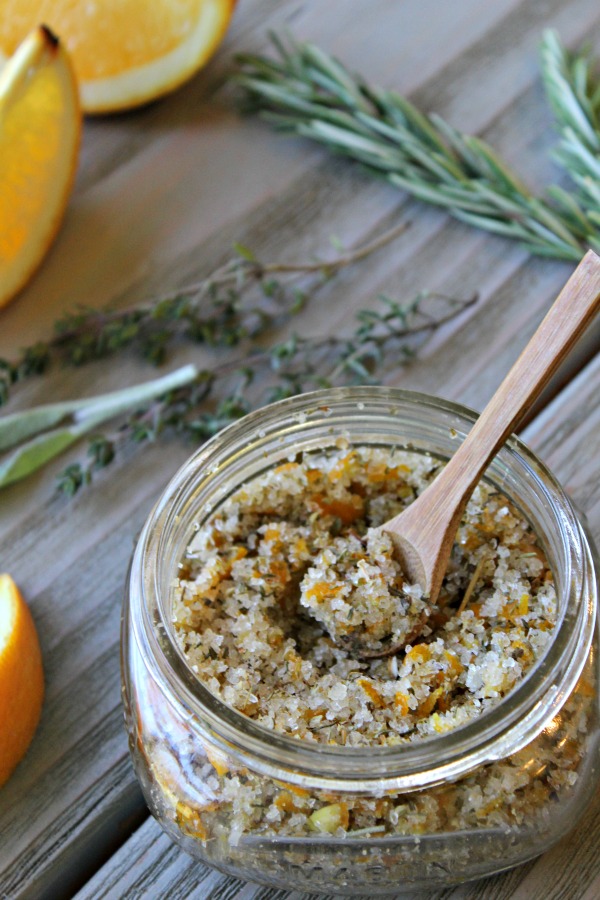
4. Try a buttermilk brine for a moist and flavorful bird.
This brine recipe is the best of both worlds and what my family has been using for the last couple years.
In this recipe, saltwater brine produces tender, juicy meat, and the addition of buttermilk adds flavor and makes the meat incredibly moist.
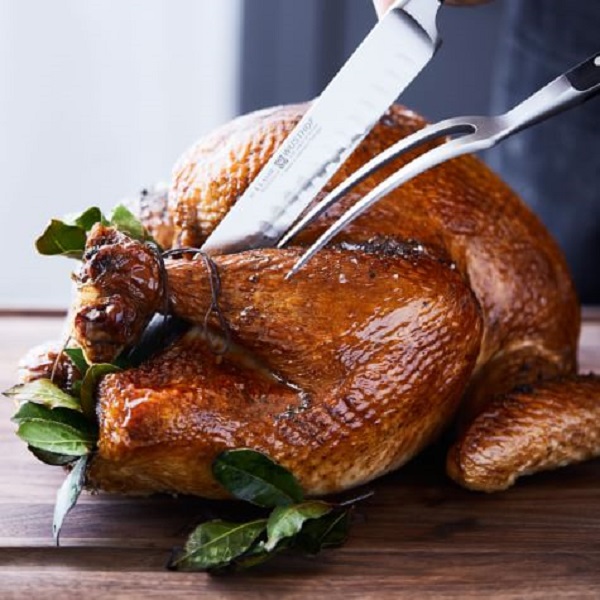
5. Use a wet brine without the mess.
Wet brining is a messy job.
Make it so much easier by brining your turkey in a clean garbage bag in your cooler. This also frees up precious refrigerator space!
See the Two-Hour Turkey recipe below for wonderful wet brining instructions from Cook’s Illustrated.
6. You may not need to brine.
Some turkey brands come already brined! Butterball turkeys “contain up to 8% of a solution of water, salt, spices, and natural flavor.”
This means that Butterball has essentially already brined the bird for you to add flavor and ensure a longer shelf life.
This is done with Kosher turkeys, as well, so don’t brine a turkey that has already been injected with salt.
7. Prep the turkey.
This article claims icing down turkey breast before cooking results in a moister bird! We will definitely be trying this incredibly easy hack this year!
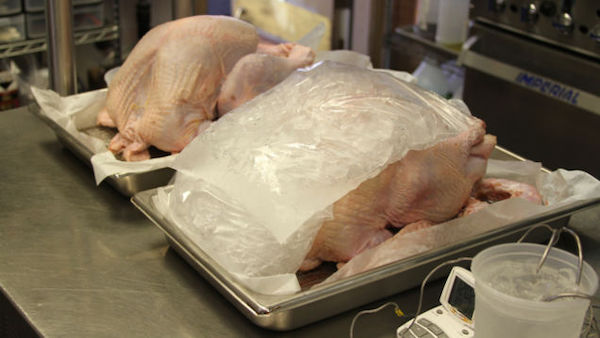
8. Season well.
If you don’t brine your turkey, you need to season it well with salt and pepper both inside the cavity and all over the top of the bird to ensure optimal flavor.
9. Don’t stuff your turkey.
Stuffing cooked in the turkey is nice and flavorful, but that stuffing comes at a price.
Cooking your stuffing in the bird will more than likely cause your turkey to be overcooked and dried out.
This is because you have to cook the turkey longer to ensure your stuffing is fully cooked to prevent cross contamination and food borne illness.
Cook your stuffing (stuffing not cooked in the bird is actually called dressing) separately in a casserole dish with the other sides while the turkey is resting, or bake your dressing in muffin cups for more crispy edges.
10. Truss your turkey.
It’s important to truss your turkey before roasting because tying it in place this way will ensure your bird is roasted evenly so that the whole bird is juicy and properly cooked.
Trussing also helps your turkey look prettier, giving it that classic, round roasted turkey look, and it helps the stuffing stay inside the bird if you stuff your turkey.
To properly truss your bird, you’ll need some kitchen twine, which should be readily available at your grocery store, butcher shop, or online here.
I like to rinse and pat the turkey dry before trussing. Then, I let the turkey warm to room temperature for about 30 minutes.
This also allows the skin to dry further, ensuring a nice, crispy skin. I also prefer to season the cavity with salt before tying, since it’s harder to access the cavity after.
Check out this video to learn how to properly truss your turkey.
11. Use a roasting rack.
If you don’t use a roasting rack, the meat on the bottom of your turkey will come out dry and overcooked.
To prevent this, you need to place your bird on a roasting rack inside your roasting pan. This Cuisinart Roasting Pan is worth the investment and can be used for loads of recipes all year long.
Don’t want to buy a roasting rack this year? That’s no problem with this easy hack!
Just about everyone has foil, especially on Turkey Day. Check out the simple tutorial at the link below.
If you prefer not to use up your foil, you can also roast your turkey on a bed of vegetables like onions, celery, and carrots cut into large chunks, which will also add flavor to your pan drippings and gravy.
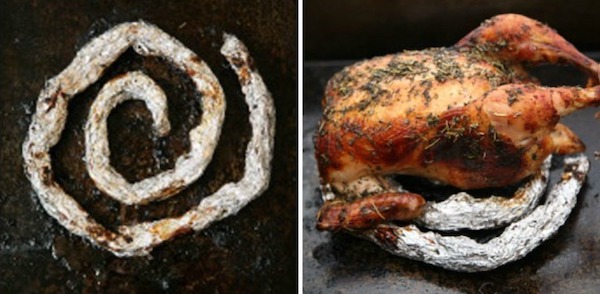
12. Change the oven temperature.
Unless you follow one of the recipes below, follow this cooking procedure for a moist bird with that flavorful, crispy skin you love.
Start cooking your turkey at 475 degree Fahrenheit for the first 30 minutes. Then, reduce the heat to 350 degrees to finish cooking the turkey.
Starting the bird at a higher temperature will quickly render fat from the turkey, resulting in the super crispy, golden skin you want.
13. Don’t baste.
You may think basting the turkey will make the meat nice and moist and the skin crispy, but that’s not really the case.
In fact, you’re actually doing more harm than good by basting because every time you open the oven door, your oven loses heat.
This means your turkey will take longer to cook, which will cause the meat to dry out. Plus, the pan drippings used in basting aren’t only made up of good, flavorful fat.
Drippings actually consist of a mixture of fat and liquid that may make your turkey skin soggy and will certainly prevent the skin from becoming as crispy and delicious as it could be.
So what should you do? Cover the skin liberally in butter to lock in moisture before baking.
Then, leave the bird alone, and let it cook. Just be sure to keep an eye on your turkey while it cooks to make sure it doesn’t burn. You can also use one of the amazing cooking methods below!
14. Slow roast your turkey while you sleep!
Now, this is a strange idea, but The Splendid Table insists that slow roasting your turkey overnight is the easiest way to cook a perfect, moist, delicious turkey every time.
Plus, you won’t have to wake up super early on Thanksgiving to get the turkey in the oven on time, and this method frees oven space for other dishes like yams and green bean casserole.
The only downside to this method seems to be that you can’t cook your stuffing in the bird. If you don’t mind cooking your stuffing separately, give this turkey cooking method a try!

15. Wrap in cheesecloth.
Wrap your turkey in a butter and herb soaked cheesecloth the entire time it bakes for perfect skin and flavorful meat and pan drippings for an out-of-this-world gravy.
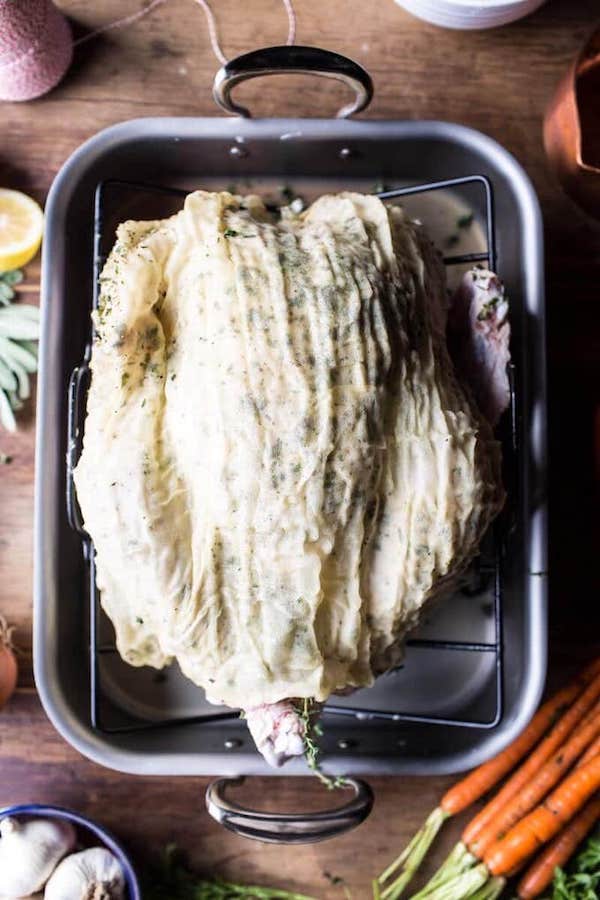
16. Wrap in bacon.
Bacon is another turkey cooking method that protects the skin. The bacon creates a barrier of salt, fat, and moisture that keeps the turkey moist and seasons with yummy bacon flavor as it cooks.
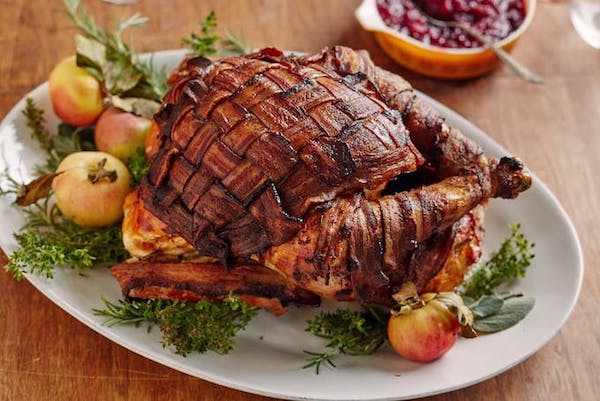
17. Cook your turkey in just two hours!
This recipe yields a fully cooked, juicy bird with crispy skin in just two hours!
Just place the turkey in a liquid brine for 6-12 hours, and roast for a moist and flavorful bird you will love.
You can’t stuff the bird because the stuffing won’t be finished in two hours. In order to fully cook stuffing, you almost always end up overcooking the bird anyway.
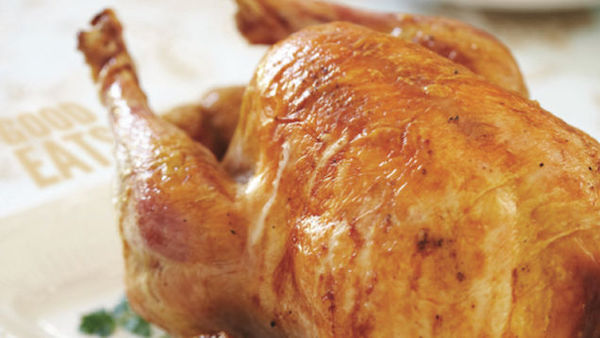
18. Prevent burning.
Covering your turkey with cheesecloth or bacon will prevent burning, but if you don’t want to follow this method, here’s another hack to ensure turkey perfection.
If you check on your turkey and notice the skin is getting too brown, don’t reduce the oven temperature.
Just loosely cover the top of the turkey with foil. This method blocks direct heat on the skin without trapping extra heat, thus preventing an overcooked and dried out turkey. Genius!
19. Cook to temp.
Sure, the package on your turkey provides those helpful roasting times, but ovens vary so these times aren’t set in stone.
You really want to check the temperature of your bird to ensure your turkey is done cooking while preventing overcooking.
The U.S. government recommends cooking to 165 degrees Fahrenheit, but check out this article that states cooking your turkey to 150 degrees will yield a far juicier bird and is perfectly safe for consumption.
Also, make sure you are using a real meat thermometer, not the pop-up thermometer that comes with the turkey. Pop-up thermometers are wildly inaccurate, and many are set to pop up at 180 degrees Fahrenheit, which is way too long to cook a turkey.
20. How to check the temperature.
I use this Instant-Read Digital Electronic Thermometer to check turkey temperature. This thermometer is super quick and accurate and can be used year-round for just about anything – even candy!
The best way to check turkey temp is to insert an instant-read thermometer into the thickest part of the thigh.
Since the meatiest part of the legs is the slowest part of the turkey to fully cook, you can be sure that if this area is done, the rest of the turkey will be done, too.
21. Moisten dry turkey.
Even the best cook can dry out a turkey – it’s so easy to do!
If this happens to you, don’t worry.
Simply pour chicken broth over the turkey to moisten and add flavor to overcooked meat. You can also do this to warm turkey pieces that have cooled to room temperature.
22. Cook white and dark meats separately.
If you’re really nervous about roasting a whole turkey, check out this video that shows you how to cut up a turkey, or just buy turkey breasts and legs.
Then, cook the white and dark meats separately with recipes like Garlic Herb Butter Roasted Turkey Breasts and White Wine Braised Turkey Legs.
If you would like to avoid the oven altogether, check out Juicy Slow Cooker Turkey Breast with a “killer gravy” recipe and Slow Cooker Turkey Leg with Honey Glaze and Garlic!
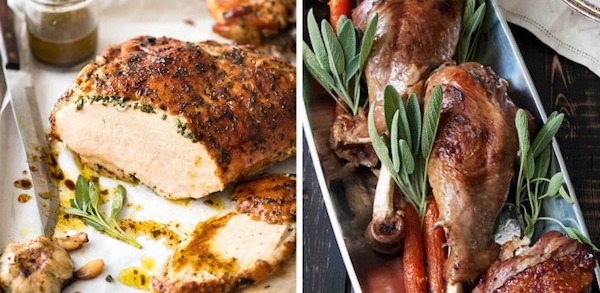
Photo Credit & Inspiration (from left): RecipeTin Eats and Food Republic
23. Let your turkey rest.
Sure, you’ll be hungry and super excited to cut into that turkey as soon as it comes out of the oven, but you really need to resist that urge. Let your turkey rest for at least 20 minutes before carving.
Doing so will result in a much juicier, tastier bird, since cutting meat immediately after cooking results in tons of lost moisture and juicy goodness.
I recommend allowing your turkey to rest while you heat your side dishes in the oven – a large bird should stay warm for up to an hour after it’s removed from the oven.
Just don’t “tent” your turkey (cover your turkey loosely) with foil while it’s resting. This will cause the skin to get soggy.
24. Carve correctly.
Check out this video to see if you’ve been carving your Thanksgiving turkey the right way.
25. Enjoy leftovers.
The best way to reheat turkey leftovers is to slice the turkey and simmer it in a skillet with gravy and some broth or water.
For more turkey day leftover tips, check out 40 Greatest Thanksgiving Leftover Recipes.
Hosting the holidays can be super stressful. These Must-Try Turkey Cooking Hacks will help you get Thanksgiving dinner on the table without a hitch!
Do you host Thanksgiving dinner? Please let me know in the comments below what you think of these helpful Turkey Cooking Hacks and if you will be using any of these tips, tricks, and recipes this year!
More Thanksgiving Hacks:
Early Thanksgiving Prep Ideas to Make the Holiday So Much Easier
10 Free and Low Cost Thanksgiving Supplies You Need for a Seamless Turkey Day
21 Thanksgiving Hacks to Make Your Holiday Super Simple
25 DIY Thanksgiving Games and Activities for a Full Day of Family Fun
30 Incredible Pumpkin Desserts Perfect for Fall
40 Greatest Thanksgiving Leftover Recipes
Thanksgiving Décor Ideas:
10 Gorgeous Fall Centerpieces That Will Wow Your Guests
20 Stylish DIY Thanksgiving Napkin Rings for a Gorgeous Holiday Table
27 Easy DIY Thanksgiving Décor Ideas Anyone Can Make
30 Easy DIY Fall Wreaths Anyone Can Make
Pin for Later:
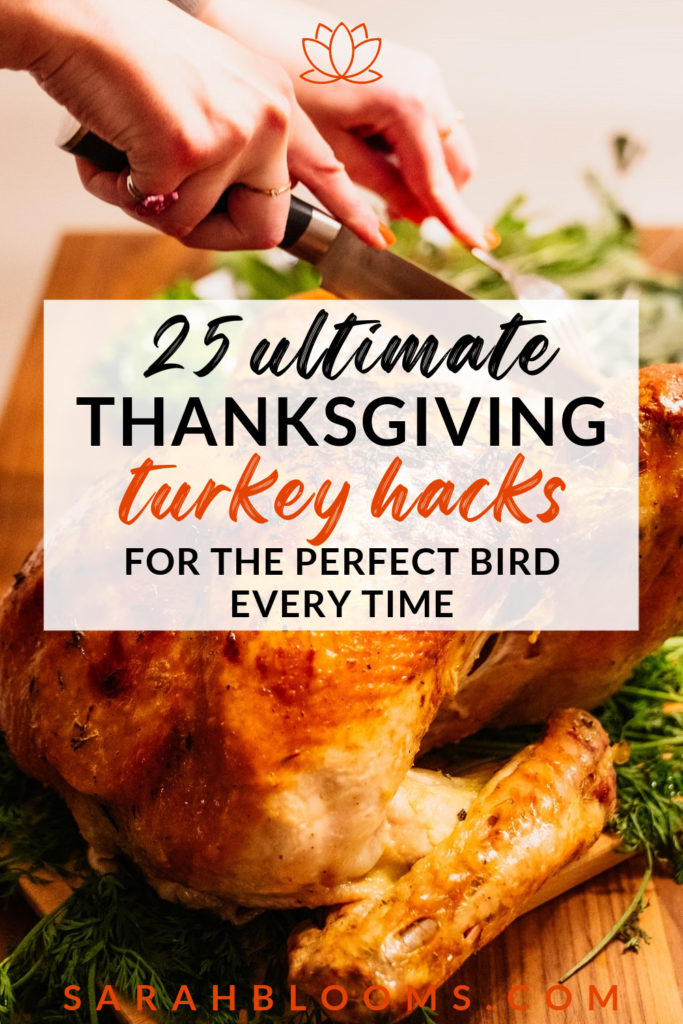
November 16, 2017
by
Sarah
Sign Up
Sign up to receive the latest news, updates, special offers, and more you won't want to miss!
Subscribe Now.
Copyright 2017-2023 • sarah Blooms
Design By Piperlane • Privacy Policy
Copyright 2017-2023 • Sarah Blooms • Design By Piperlane
View the Comments
Add a Comment
Comments will load here